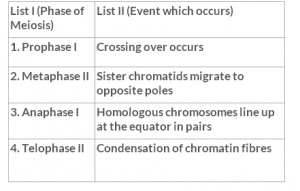NEET Exam > NEET Tests > Biology Class 11 > Test: Meiosis - NEET MCQ
Test: Meiosis - NEET MCQ
Test Description
10 Questions MCQ Test Biology Class 11 - Test: Meiosis
Test: Meiosis for NEET 2025 is part of Biology Class 11 preparation. The Test: Meiosis questions and answers have been
prepared according to the NEET exam syllabus.The Test: Meiosis MCQs are made for NEET 2025 Exam. Find important
definitions, questions, notes, meanings, examples, exercises, MCQs and online tests for Test: Meiosis below.
Solutions of Test: Meiosis questions in English are available as part of our Biology Class 11 for NEET & Test: Meiosis solutions in
Hindi for Biology Class 11 course. Download more important topics, notes, lectures and mock
test series for NEET Exam by signing up for free. Attempt Test: Meiosis | 10 questions in 10 minutes | Mock test for NEET preparation | Free important questions MCQ to study Biology Class 11 for NEET Exam | Download free PDF with solutions
Detailed Solution for Test: Meiosis - Question 1
Test: Meiosis - Question 2
Which of the following is the correct sequence for a meiotic cell cycle?
S → G1 → G2 → M → S
G1 → S → G2 → M → G1
G2 → G1 → S → M → G2
G1 → G2 → S → M → G2
S → G1 → G2 → M → S
G1 → S → G2 → M → G1
G2 → G1 → S → M → G2
G1 → G2 → S → M → G2
Detailed Solution for Test: Meiosis - Question 2
Detailed Solution for Test: Meiosis - Question 3
Test: Meiosis - Question 4
Cross-like configurations when non-sister chromatids of a bivalent come in contact during the first meiotic division are
Detailed Solution for Test: Meiosis - Question 4
Detailed Solution for Test: Meiosis - Question 5
Test: Meiosis - Question 6
When synapsis is complete all along the chromosome, the cell is said to have entered a stage called
Detailed Solution for Test: Meiosis - Question 6
Detailed Solution for Test: Meiosis - Question 7
Detailed Solution for Test: Meiosis - Question 8
Detailed Solution for Test: Meiosis - Question 9
Test: Meiosis - Question 10
In meiosis, the daughter cells are not similar to the parent because of
Detailed Solution for Test: Meiosis - Question 10
|
180 videos|362 docs|148 tests
|
Information about Test: Meiosis Page
In this test you can find the Exam questions for Test: Meiosis solved & explained in the simplest way possible.
Besides giving Questions and answers for Test: Meiosis, EduRev gives you an ample number of Online tests for practice





















